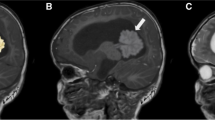Abstract
Background
Neuroblastic tumors cause spinal cord compression when they arise primarily in the spinal canal or invade it through the radicular foramen. Whereas neuroblastomas (NB) are relatively common and are generally treated with chemotherapy, mature neuroblastic tumors (MNT), which include intermixed ganglioneuroblastomas (iGNB) and ganglioneuromas (GN), are less common and the role of surgery is more prominent. Because MNT are rare and have been separated only recently from NB, their clinical and radiological features as well as the role of surgery are poorly defined.
Materials and methods
In order to increase our knowledge on MNT, we reviewed our database for cases operated for spinal cord compression in our department since the introduction of magnetic resonance imaging (MRI). We treated four cases of NB and one case of iGNB presenting primarily with spinal cord compression.
Report of cases
MNT represented 10% of spinal tumors and 1.6% of all tumors of the nervous system in our pediatric neurosurgical practice. The neurological and oncological outcomes were generally favorable after surgical resection, followed by orthotic treatment. In one case with neurofibromatosis type 1, the tumor was inoperable and the child died of tumor progression several years later.
Conclusion
GN, and some iGNB, are chemo-insensitive and can only be cured by surgical removal. Surgery is an emergency in case of rapidly progressing paraplegia and can be challenging because the tumor is often hard and hemorrhagic. In case of subtotal removal, tumor remnants can stay stable without oncological treatment.


Similar content being viewed by others
References
Kleihues P, Burger PC, Scheithauer BW (1993) The new WHO classification of brain tumours. Brain Pathol 3:255–268
Plantaz D, Rubie H, Michon J, Mechinaud F, Coze C, Chastagner P, Frappaz D, Gigaud M, Passagia JG, Hartmann O (1996) The treatment of neuroblastoma with intraspinal extension with chemotherapy followed by surgical removal of residual disease. A prospective study of 42 patients—results of the NBL 90 Study of the French Society of Pediatric Oncology. Cancer 78:311–319
Katzenstein HM, Kent PM, London WB, Cohn SL (2001) Treatment and outcome of 83 children with intraspinal neuroblastoma: the Pediatric Oncology Group experience. J Clin Oncol 19:1047–1055
Sibilla L, Martelli A, Farina L, Uggetti C, Zappoli F, Sessa F, Baena R, Gaeltani P (1995) Ganglioneuroblastoma of the spinal cord. AJNR Am J Neuroradiol 16:875–877
Hayes FA, Green AA, Rao BN (1989) Clinical manifestations of ganglioneuroma. Cancer 63:1211–1214
Yiin JJ, Chang CS, Jan YJ, Wang YC (2003) Treatment of neuroblastoma with intraspinal extensions. J Clin Neurosci 10:579–583
Sandberg DI, Bilsky MH, Kushner BH, Souweidane MM, Kramer K, Laquaglia MP, Panageas KS, Cheung NK (2003) Treatment of spinal involvement in neuroblastoma patients. Pediatr Neurosurg 39:291–298
Frankel HL (1975) Traumatic paraplegia. Nurs Mirror Midwives J 141:48–52
Lansky LL, List MA, Lansky SB, Cohen ME, Sinks LF (1985) Toward the development of a play performance scale for children (PPSC). Cancer 56:1837–1840
Friedman JM, Gutmann DH, MacCollin M, Riccardi VM (2000) Clinical and epidemiological features in Neurofibromatosis, 3rd edn. Johns Hopkins, Baltimore, pp 29–89
Schwab M, Shimada HJV, Brodeur GM (2000) Neuroblastic tumours of the adrenal gland and sympathic nervous system. IARC, Lyon, pp 153–161
Geraci AP, de Csepel J, Shlasko E, Wallace SA (1998) Ganglioneuroblastoma and ganglioneuroma in association with neurofibromatosis type I: report of three cases. J Child Neurol 13:356–358
Lonergan GJ, Schwab CM, Suarez ES, Carlson CL (2002) Neuroblastoma, ganglioneuroblastoma, and ganglioneuroma: radiologic–pathologic correlation. Radiographics 22:911–934
Candito M, Thyss A, Albertini M, Deville A, Politano S, Mariani R, Chambon P (1992) Methylated catecholamine metabolites for diagnosis of neuroblastoma. Med Pediatr Oncol 20:215–220
Geoerger B, Hero B, Harms D, Grebe J, Scheidhauer K, Berthold F (2001) Metabolic activity and clinical features of primary ganglioneuromas. Cancer 91:1905–1913
Hoover M, Bowman LC, Crawford SE, Stack C, Donaldson JS, Grayhack JJ, Tomita T, Cohn SL (1999) Long-term outcome of patients with intraspinal neuroblastoma. Med Pediatr Oncol 32:353–359
Author information
Authors and Affiliations
Corresponding author
Rights and permissions
About this article
Cite this article
Duhem-Tonnelle, V., Vinchon, M., Defachelles, AS. et al. Mature neuroblastic tumors with spinal cord compression: report of five pediatric cases. Childs Nerv Syst 22, 500–505 (2006). https://doi.org/10.1007/s00381-005-0009-z
Received:
Revised:
Published:
Issue Date:
DOI: https://doi.org/10.1007/s00381-005-0009-z




